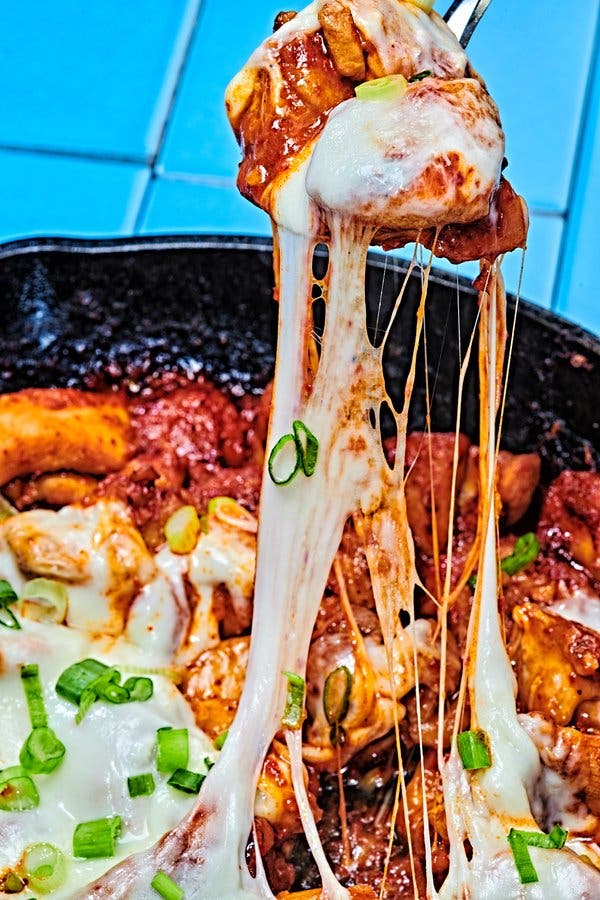I first laid eyes on cheese buldak, a mozzarella-cloaked Korean dish that translates as “fire chicken,” in a 24-hour restaurant off Wilshire Boulevard in Los Angeles. It was very late at night, and a couple in a window table were pulling long strings of melting cheese off a sizzling platter that beneath its glistening white blanket revealed a steaming pile of bright red chicken drenched in a thick, fragrant sauce. The couple appeared to be in a kind of happy daze, eating silently, mopping their brows, checking the social media feeds on their phones and then returning to the cheese, the chicken, an occasional bite of rice. My ox-bone soup, light and restorative, seemed flat by comparison. I became bored by it, and clomped off into the darkness. I’d made a mistake in ordering and was filled with regret.
Now I cook buldak all the time, using an adaptation of a recipe that owes its deepest debt to Emily Kim, the Korean web star known as Maangchi. Her video recipe for cheese buldak has been viewed on YouTube more than seven million times and, thanks to subtitling by her fans, can be read in 24 languages. There are thousands and thousands of comments below it, mostly positive. One reads, “Can you be my mom.”
Cheese has not, historically, played much of a role in Korean cuisine. With the exception of the processed American cheese that could be found across the peninsula in the wake of the Korean War, Koreans barely ate cheese until recently. It was expensive and rare. In 1970, researchers say, South Koreans consumed roughly five grams of milk and dairy products a year, per capita. (That’s about the weight of a nickel.) Then came, among other things, chain pizza. Pizza Hut opened in Seoul in the mid-1980s, with Domino’s and Mr. Pizza following soon after, flooding the nation with franchises. By 1990, per capita yearly milk and dairy consumption in South Korea was up to 50 grams. By 2018 it was 2.5 kilograms, or roughly 5.5 pounds. (Americans consume roughly 37 pounds of cheese a year, per capita.)

CreditBobby Doherty for The New York Times. Food stylist: Maggie Ruggiero. Prop stylist: Margaret MacMillan Jones.
The same cheap, low-moisture mozzarella that tops a delivery pizza is what covers cheese buldak too. Its bland, rubbery sweetness helps temper the spiciness of the dish, which is built on a foundation of chicken set in a sauce of immense heat. The primary ingredients are gochujang, the Korean red-pepper sauce, and gochugaru, dried red peppers that are processed into something that is not quite ground, not quite flaked. Hooni Kim, the chef who owns and operates two beloved Korean restaurants in Manhattan and who is finishing work on his first cookbook, “My Korea: Traditional Flavors, Modern Recipes,” recalled his first time eating cheese buldak, 16 years ago, during a visit to South Korea to meet his future wife’s parents. “It was extremely painful,” he told me in an email, “but so, so good.” Kim told me melting cheese on top of the dish has an additional benefit, at least for Korean restaurateurs: It makes the dish appear a little more Western, he said, like a kind of spice-laden chicken Parm, which means it can be sold at a premium.
Here in the West, it is almost comically simple to prepare the dish, just as long as you can find the gochujang and the gochugaru — which of course you can, if only on the internet. The rest is heating and melting. You make a marinade that will become the sauce, soak the chicken in it, then cook them both on the stovetop in a pan, finishing the dish by strewing cheese across the top and running the whole thing beneath a broiler.
Earlier in the summer, I drove out to Montauk, at the tip of Long Island in New York, to cook buldak with Maangchi and to thank her for her recipe. I was a little nervous because I’d changed some ingredients and steps. I use chicken thighs instead of the breasts Maangchi calls for, because I prefer them. I also generally omit the cylindrical rice cakes she adds to the pan for reasons of texture. (They’re hard to find!) And sometimes I grill the chicken instead of sautéing it, then put it into a pan and cover with cheese to melt just as you’d do with a cheeseburger.
Maangchi was on vacation, staying in a beachside condominium with her husband. She accepted my hacks with relaxed good humor. She made a few of her own that day. Their unit’s kitchen had neither a grill nor an oven, she said, so she would make the dish on a stovetop from start to finish, using the lid of her pan to melt the cheese. This took maybe 30 minutes, contained precisely no surprises and tasted exactly as delicious as it has every time I’ve eaten it. Which makes it an ideal dish, I think, to introduce to people who say they don’t know how to cook. “Exactly,” Maangchi said, laughing. “They can cook this!”





